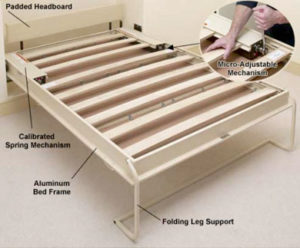In this short article, we’ll go over the basics of Murphy beds and how they work. As well, we’ll cover a little bit of the surprisingly long and storied history of wall beds- and where they got the name “Murphy” in the first place. If anything, this should be fun trivia to wow people at parties.
Why is it called a Murphy Bed?
Around 1900, William Murphy was living in San Francisco with his wife in a small one-room apartment. Their conventional bed took up most of their floor space, leading to cramped conditions. As well, they could not entertain guests, since there was no room. He began to investigate how to solve this situation by experimenting with a folding bed that stood vertically against the wall when not in use. His experiments were a success and the first “Murphy” bed was created.
Soon Murphy created a wall bed company based in San Francisco to help urban dwellers with the same problem he had. After some success, the company moved to New York and wall bed technology spread to most major cities in the United States and abroad.

They were also often used for comedic relief. Pictured above is Charlie Chaplain in One A.M. doing battle with a Murphy Bed.
So what is a wall bed?
A wall bed is a kind of bed that is designed to be stored vertically against a wall. While the most basic wall beds simply stand on end against a wall, most units are designed to be concealed within a cabinet, furniture piece, or behind a door.
This vertical storage helps free up floor space and make a room multi-functional. Total concealment of the bed also effectively doubles the living space of a small apartment, since each room now can serve as both a bedroom and an office or a living room.
In order to achieve this vertical storage and concealment, a standard mattress is placed upon a wall bed hinging mechanism. This wall bed mechanism is essentially a bed frame hinged on one end. The hinged end is anchored to the wall so that the bed can easily pivot up and down when not in use. Often, a strap is used to hold the mattress to the frame while in vertical position. As well, either cabinetry or book shelves the same height and depth as the bed are put on either side of the bed to help anchor and conceal it.

